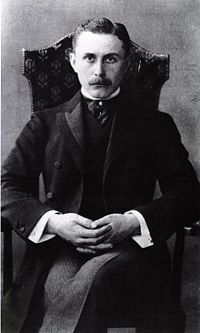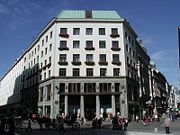Adolf Loos
| Adolf Loos | |
 |
|
| Personal information | |
|---|---|
| Name | Adolf Loos |
| Birth date | December 10, 1870 |
| Birth place | Brno, Austria-Hungary |
| Date of death | August 23, 1933 (aged 62) |
| Place of death | Vienna, Austria |
| Work | |
| Significant buildings | Steiner House, Goldman & Salatsch Building (Looshaus) |
Adolf Loos (10 December 1870 – 23 August 1933) was one of the most important and influential Austrian and Czechoslovak[1] architects of European Modern architecture. In his essay "Ornament and Crime" he repudiated the florid style of the Vienna Secession, the Austrian version of Art Nouveau. In this and many other essays he contributed to the elaboration of a body of theory and criticism of Modernism in architecture.
Contents |
Life
Born in 1870 in Brno, Moravia, Loos was only nine when his stonemason father died. A rebellious boy who rather lost his bearings, he failed in various attempts to get through architecture school. Contracting syphilis in the brothels of Vienna, by 21 he was sterile and in 1893 his mother disowned him. He went to America for three years, and did odd jobs in New York, somehow finding himself in that process and returning to Vienna in 1896 a man of taste and intellectual refinement, immediately entering the fashionable Viennese intelligentsia. His friends included Ludwig Wittgenstein, Arnold Schönberg, and Karl Kraus. He quickly established himself as the preferred architect of Vienna’s cultured bourgeoisie. Diagnosed with cancer in 1918, his stomach, appendix and part of his intestine were removed. For the rest of his life he could only digest ham and cream. He had several unhappy marriages. By the time he was fifty he was almost completely deaf; in 1928 he was disgraced by a paedophilia scandal and at his death in 1933 at 63 he was penniless.[2] He died in Kalksburg near Vienna.
Architectural theory
To fully understand Loos’s radical, innovative outlook on life, his admiration for the classical tradition, his passion for all aspects of design, lifestyle and taste, and the breadth of his ideas it is essential to read his own collected writings, which were published by MIT press in English as “Spoken into the Void” in 1982.
In his essays, Loos was fond of using the provocative catch phrase and has become noted for one particular essay/manifesto entitled Ornament and Crime written in 1908, in which he repudiated the florid style of the Vienna Secession, the Austrian version of Art Nouveau.
In this essay, he explored the idea that the progress of culture is associated with the deletion of ornament from everyday objects, and that it was therefore a crime to force craftsmen or builders to waste their time on ornamentation that served to hasten the time when an object would become obsolete. Perhaps surprisingly, Loos' own architectural work is often elaborately decorated. The visual distinction is not between complicated versus plain, but between "organic" and superfluous decoration.
Loos was also interested in the decorative arts, collecting sterling silver and high quality leather goods, which he noted for their plain yet luxurious appeal. He also enjoyed fashion and men's clothing, designing the famed Knize of Vienna, a haberdashery.
Loos is known for his entry to the 1922 Chicago Tribune competition, which took the form of a single colossal Doric column. But it was in the field of private houses that he most completely developed his unique spatial language.
Major works

- 1908 American Bar, Vienna
- 1910 Steiner House, Vienna
- 1910 Goldman & Salatsch Building, a mixed-use building overlooking Michaelerplatz, Vienna (known colloquially as the "Looshaus")
- 1922 Rufer House, Vienna
- 1925 Maison Tzara, house and studio for Tristan Tzara, one of the founders of Dadaism, in Montmartre, Paris, GIS coordinates: +48.888146, +2.335500
- 1926 Villa Moller, Vienna
- 1927 House (not built) in Paris for the American entertainer Josephine Baker
- 1928 Villa Muller de:Villa Müller, Prague (now in the Czech Republic)
- 1929 Khuner Villa, Kreuzberg, Austria
Notes
- ↑ http://www.architektursprache.de/pdf/02.01.02_adolf-loos.pdf
- ↑ Bock, Ralf (2007). Adolf Loos. Geneve: Skira. ISBN 8876246436.
Bibliography
- Loos, Adolf (2007-05-02). On Architecture. Ariadne Press. pp. 216. ISBN 1572410981.
- Loos, Adolf; Adolf Opel (1997-11-15). Ornament and Crime: Selected Essays. Ariadne Press (CA). pp. 204. ISBN 1572410469.
- Loos, Adolf (1982) (in German). Trotzdem, 1900-1930. G. Prachner. pp. 218. ISBN 3853670377.
- Loos, Adolf; Heinrich Kulka (1931) (in German). Adolf Loos: Das Werk des Architekten. Anton Achroll & Co, Neues Bauen in Der Welt, IV.
- Loos, Adolf (1983) (in German). Die Potemkin'sche Stadt: Verschollene Schriften, 1897-1933. Prachner. pp. 231. ISBN 3853670385.
References
- Gravagnuolo, Benedetto (1995). Adolf Loos, Theory and Works. London: Art Data. ISBN 0948835168.
- Bock, Ralf (2007). Adolf Loos. Geneve: Skira. ISBN 8876246436.
- Rukschcio, Burkhardt; Schachel, Roland (1982). Adolf Loos-Leben Und Werk. Salzburg: Residenz. ISBN 3701702888.
- Foster, Hal (2003). Design and Crime (And other diatribes). London: Verso. ISBN 9781859844533.
- Ottillinger, Eva (1994). Adolf Loos Wohnkonzepte und Möbelentwürfe.. Salzburg: Residenz Verlag. ISBN 9783701708505.
- Gemmel, Mirko (2005-10). Die Kritische Wiener Moderne: Karl Kraus, Adolf Loos, Ludwig Wittgenstein - Ethik und Ästhetik. Berlin: Parerga Verlag. pp. 439. ISBN 3937262202.
- Oechslin, Werner, "Stilhülse und Kern : Otto Wagner, Adolf Loos und der evolutionäre Weg zur modernen Architektur", Zuerich 1994.
External links
- Adolf Loos at the archINFORM database
- Biography and significant buildings of Loos in Vienna
- Life and important works
- Muirhead, Thomas. "Adolf Loos seen through the keyhole". Building Design. Retrieved on 11-19, 2007.
| Persondata | |
|---|---|
| NAME | Loos, Adolf |
| ALTERNATIVE NAMES | |
| SHORT DESCRIPTION | Austrian Architect |
| DATE OF BIRTH | 1870-12-10 |
| PLACE OF BIRTH | Brno |
| DATE OF DEATH | 1933-08-23 |
| PLACE OF DEATH | Kalksburg |